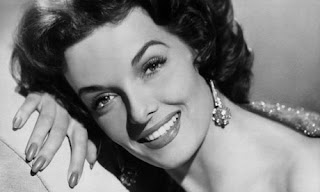We look back at Jane Russell's movie career, from The Outlaw through Gentlemen Prefer Blondes to her late-60s cameos.
As a 20-year-old and the object of Howard Hughes's attentions, Jane Russell was force-fed into a series of low-cut dresses for The Outlaw (1943).
She plays Doc Holliday's girl Rio, who falls in love with a wounded Billy the Kid when he hides out with her, on the run from Pat Garrett. Not remotely historically accurate, this blood-heat western is best remembered for the censorship squabbles over exactly how far Russell was allowed to lean over while tenderly ministering to the Kid. Hughes's legendary underwired cantilevered brassiere was designed during the shooting of the film, but Russell denied she ever wore it.
The Paleface (1948) was a real change of pace: a comedy western with Bob Hope as the useless dentist Peter Potter, who plays husband to Russell's deep-cover Calamity Jane. Songs, giggles and full Technicolor, it was a recipe for success that made a sequel, Son of Paleface (1952), inevitable. Here's Hope and Russell doing Buttons and Bows – so good they had to do it twice. Russell gets a bit more of a look-in in the second film.
Another profitable pairing for Russell was with lazy-eyed Robert Mitchum, opposite whom she played nightclub canaries in two successive noirs: His Kind of Woman (1951) and Macao (1952). In the former, she and Mitchum meet up in a sleazy Mexican bar, while the second, a globetrotting affair in the mould of Josef von Sternberg's pre-war Shanghai Express, has Russell belting out torch classics like One for My Baby. Von Sternberg, though, was fired during production after repeatedly clashing with Mitchum; Nicholas Ray was brought in to finish things up.
Russell's best-known film, and the one she'll always be remembered
for, is one in which, even though she had top billing, she pretty much
played second fiddle to emergent superstar Marilyn Monroe. The "two
little girls from Little Rock" in Gentlemen Prefer Blondes (1953) were perfect sweater-girl fantasy figures for the mid-1950s: Monroe blonde and ditsy, Russell dark and sassy. Russell's apparent acceptance of Monroe's bombshell superiority – and ability to parody it – won her lots of friends. She may not have got to sing Diamonds Are a Girl's Best Friend, but she did have Ain't There Anyone Here for Love.
After this high point, Russell's star began to decline. Howard Hughes had her courting controversy once again in The French Line (1954), in
which she pranced around in a then-outrageous swimsuit with holes cut
in it. She made the epic cattle-drive western The Tall Men (1955) for director Raoul Walsh, opposite Clark Gable; her own production outfit made Gentlemen Marry Brunettes (1955), a sort of semi-sequel to Blondes, with Jeanne Crain in the Monroe role, and she played tough in The Revolt of Mamie Stover (1956), as a hardboiled dancehall hostess who tries to make a go of it in Hawaii.
The truth was, though, that as the 1950s wore on, Russell's smouldering, tight-lipped charms seemed more and more out of place, and, after the failure of The Fuzzy Pink Nightgown (1957), she more or less packed in movie-making. Her commitment to Christianity and rightwing politics – surprising, you might think, for such a censor-baiting figure – helped push her away from Hollywood. She made a few cameos in the late 60s – including a turn in biker exploitation flick The Born Losers (1967), the original Billy Jack movie – but nothing she was ever proud of.
